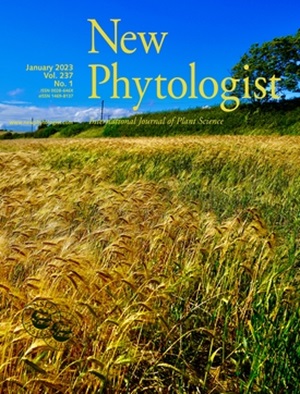Microbial terroir: associations between soil microbiomes and the flavor chemistry of mustard (Brassica juncea)
IF 8.1
1区 生物学
Q1 PLANT SCIENCES
引用次数: 0
Abstract
- Here, we characterized the independent role of soil microbiomes (bacterial and fungal communities) in determining the flavor chemistry of harvested mustard seed (Brassica juncea). Given the known impacts of soil microbial communities on various plant characteristics, we hypothesized that differences in rhizosphere microbiomes would result in differences in seed flavor chemistry (glucosinolate content).
- In a glasshouse study, we introduced distinct soil microbial communities to mustard plants growing in an otherwise consistent environment. At the end of the plant life cycle, we characterized the rhizosphere and root microbiomes and harvested produced mustard seeds for chemical characterization. Specifically, we measured the concentrations of glucosinolates, secondary metabolites known to create spicy and bitter flavors. We examined associations between rhizosphere microbial taxa or genes and seed flavor chemistry.
- We identified links between the rhizosphere microbial community composition and the concentration of the main glucosinolate, allyl, in seeds. We further identified specific rhizosphere taxa predictive of seed allyl concentration and identified bacterial functional genes, namely genes for sulfur metabolism, which could partly explain the observed associations.
- Together, this work offers insight into the potential influence of the belowground microbiome on the flavor of harvested crops.
微生物风土:土壤微生物群与芥菜(Brassica juncea)风味化学之间的关联。
在这里,我们描述了土壤微生物群落(细菌和真菌群落)在决定收获芥菜种子(芥蓝)风味化学性质方面的独立作用。鉴于已知土壤微生物群落对各种植物特征的影响,我们假设根瘤微生物群落的差异会导致种子风味化学成分(葡萄糖苷酸含量)的差异。在一项玻璃温室研究中,我们将不同的土壤微生物群落引入到在其他环境中生长的芥菜植物中。在植物生命周期的末期,我们对根圈和根部微生物群落进行了表征,并收获了生产的芥菜种子进行化学表征。具体来说,我们测量了葡萄糖苷酸盐的浓度,众所周知,葡萄糖苷酸盐是产生辛辣和苦味的次级代谢产物。我们研究了根圈微生物类群或基因与种子风味化学之间的关联。我们确定了根圈微生物群落组成与种子中主要葡糖苷酸(烯丙基)浓度之间的联系。我们进一步确定了可预测种子烯丙基浓度的特定根圈类群,并确定了细菌功能基因(即硫代谢基因),这些基因可部分解释所观察到的关联。总之,这项工作让我们深入了解了地下微生物群对收获作物风味的潜在影响。
本文章由计算机程序翻译,如有差异,请以英文原文为准。
求助全文
约1分钟内获得全文
求助全文
来源期刊

New Phytologist
生物-植物科学
自引率
5.30%
发文量
728
期刊介绍:
New Phytologist is an international electronic journal published 24 times a year. It is owned by the New Phytologist Foundation, a non-profit-making charitable organization dedicated to promoting plant science. The journal publishes excellent, novel, rigorous, and timely research and scholarship in plant science and its applications. The articles cover topics in five sections: Physiology & Development, Environment, Interaction, Evolution, and Transformative Plant Biotechnology. These sections encompass intracellular processes, global environmental change, and encourage cross-disciplinary approaches. The journal recognizes the use of techniques from molecular and cell biology, functional genomics, modeling, and system-based approaches in plant science. Abstracting and Indexing Information for New Phytologist includes Academic Search, AgBiotech News & Information, Agroforestry Abstracts, Biochemistry & Biophysics Citation Index, Botanical Pesticides, CAB Abstracts®, Environment Index, Global Health, and Plant Breeding Abstracts, and others.
 求助内容:
求助内容: 应助结果提醒方式:
应助结果提醒方式:


